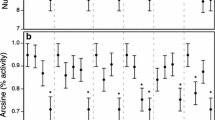Abstract
Materials previously shown to elicit increased tongue-flicking and prey attack in garter snakes (Thamnophis sirtalis) were isolated from both earthworms (Lumbricus terrestris) and fish (Pimephales promelas). Both high- and low-molecular-weight components from earthworms and fish stimulated attacks and increased tongue-flicking in previously unfed neonate garter snakes relative to distilled water controls. Earthworm collagen was also effective, but even concentrated fractions were less effective than raw extract. Conflicting reports on the effectiveness of collagen suggest that the salient chemical(s) is a smaller molecule tightly bound to collagen and resisting standard purification methods.
Similar content being viewed by others
References
Arnold, S.J. 1981. The microevolution of feeding behavior, pp. 409–453,in A. Kamil and T. Sargent (eds.). Foraging Behavior: Ecological, Ethological, and Psychological Approaches. Garland STPM, New York.
Burghardt, G.M. 1969. Comparative prey-attack studies in newborn garter snakes of the genusThamnophis.Behavior 33:77–114.
Burghardt, G.M. 1970. Chemical perception in reptiles, pp. 241–308,in J.W. Johnston, Jr., D.G. Moulton, and A. Turk (eds.). Communication by Chemical Signals. Appleton-Century-Crofts, New York.
Burghardt, G.M. 1980. Behavioral and stimulus correlates of vomeronasal functioning in reptiles: Feeding, grouping, sex, and tongue use, pp. 275–301,in D. Müller-Schwarze and R.M. Silverstein (eds.). Chemical Signals in Vertebrates and Aquatic Invertebrates. Plenum, New York.
Burghardt, G.M., Goss, S.E., andSchell, F.M. 1988. Comparison of earthworm- and fish-derived chemicals eliciting prey attack by garter snakes (Thamnophis).J. Chem. Ecol. 14:855–881.
Cooper, W.E., andBurghardt, G.M. 1990. A comparative analysis of scoring methods for chemical discrimination of prey by squamate reptiles.J. Chem. Ecol. 16:45–65.
Goss, S.E. 1986. The isolation of prey identification substances that are utilized by garter snakes. Unpublished MS thesis. The University of Tennessee, Knoxville, Tennessee.
Halpern, M., andKubie, J. 1984. The role of the ophidian vomeronasal system in species-typical behavior.Trends Neurosci. 7:472–477.
Halpern, M., Schulman, W., andKirschenbaum, D.M. 1986. Characteristics of earthworm washings detected by the vomeronasal system of snakes, pp. 63–77,in D. Duvall, D. Müller-Schwarze, and R. M. Silverstein (eds.). Chemical Signals in Vertebrates, Vol. 4. Plenum, New York.
Kirschenbaum, D.M., Schulman, N., andHalpern, M. 1986. Earthworms produce a collagenlike substance detected by the garter snake vomeronasal system.Proc. Natl. Acad. Sci. U.S.A. 83:1213–1216.
Muir, L., andLee, Y. 1970. Glycopeptides from earthworm cuticle collagen.J. Biol. Chem. 245:502–509.
Murray, L.S., Waite, J.H., Tanzer, M.L., andHauschka, P.V. 1982. Preparation and characterization of invertebrate collagens.Methods Enzymol. 82:65–95.
Sheffield, L.P., Law, J.L., andBurghardt, G.M. 1968. On the nature of chemical food sign stimuli for newborn garter snakes.Commun. Behav. Biol. 2A:7–12.
Author information
Authors and Affiliations
Rights and permissions
About this article
Cite this article
Schell, F.M., Burghardt, G.M., Johnston, A. et al. Analysis of chemicals from earthworms and fish that elicit prey attack by ingestively naive garter snakes (Thamnophis). J Chem Ecol 16, 67–77 (1990). https://doi.org/10.1007/BF01021268
Received:
Accepted:
Issue Date:
DOI: https://doi.org/10.1007/BF01021268




